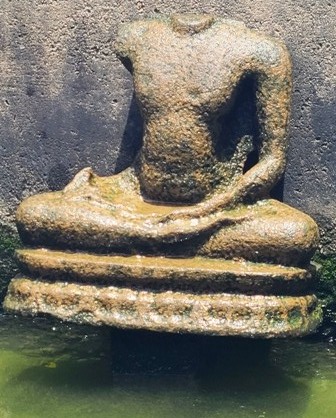Mangalore: In recent archaeological explorations conducted in Kadri at Mangalore, a headless Buddha sculpture and a group of caves of great importance newly discovered says Prof. T. Murugeshi, a retired Associate Professor in Ancient History and Archaeology, MSRS College, Shirva, in his press release here today.

The Buddha image is found in the water of a tank nearby the Kadri Manjunatha temple in a discarded state of condition. It was uplifted from the water for study with the permission of the temple administrator.

The Buddha image is highly corroded. The head is chapped off and right hand destroyed, but, still it has its serene beauty in its physical appearance. Lord Buddha is seated in Padmasana pose on the Padma Pita in Dhyana Mudra by placing both palms above the centre of legs. The upper cloth passing over the left shoulder is laying flat on the chest very indistinctly visible. The pillar in the outer prakara of the temple is having Dhyani Buddha sculptures seated on lotus. Thus, this sculpture under study is identified as Dhyani Buddha beyond doubt. The Buddha image is about 68 cm in height and 48 cm in width including the prop of the image. The Buddha image is stylistically datable to 4th -6th century A.D. It is suppose to be the presiding deity of the temple.
The Caves:
A group of three rock cut caves found above the eastern side of Kadri tanks is of curious interest. They cut in laterite above the ground. The first one from right is about 8 feet in height and has a semi circular entrance like a porthole. It has a single square room with a small provision for lamp. The entire structure looks like a Megalithic Dolmen. The middle and third one are having a high plinth and two square entrances with single square rooms. All caves having a sloppy canopy with holes to clear off rainy water. The nature of the caves clearly indicates that they were used for residential purpose.
Significance of the Discovery:
Mangalore is a very important harbour city on the west coast of South India. It has unknown stories of great antiquity like this. The present discovery under study has a great importance in the South Asian Buddhist studies and Tuluva history as well. The image has close similarities with that of Buddha image found at Mushira Waddo in Colvale of Goa, now displayed in Fr. Heras Institute, located in St. Xavier’s College, Mumbai. The Dhyani Buddha image belongs to Mahayana Buddhism and caves also belongs to the Mahayanist. By this discovery the decades of controversy over Kadri, whether it was a Buddhist centre or not is very clear. Kadri is a Buddhist centre over the century’s right up to 10th century A.D. as revealed by the inscription of Alupa king Kundavarma found on the Lokeshwara image of Kadri temple. The Mahayana Buddhist was replaced by Vajrayana Buddhist and they were turned out by Natha cult in 11th century.
I am thankful to Arun Kumar the temple administrator for his kind permission and my students Shreyas Kolpe a PhD student of Manipal University, Shreyas, Assistant Lecturer in Ancient History & Archaeology, MSRS College, Shirva, Karthik, a Post graduate student in archaeology from University College, Mangalore and Ravindra Kushwaha a graduate student in archaeology MSRS College Shirva, for their help in fieldwork.
I am hereby requesting the commissioner of state archaeology to take steps to recover this rare antiquity and protect immediately.
